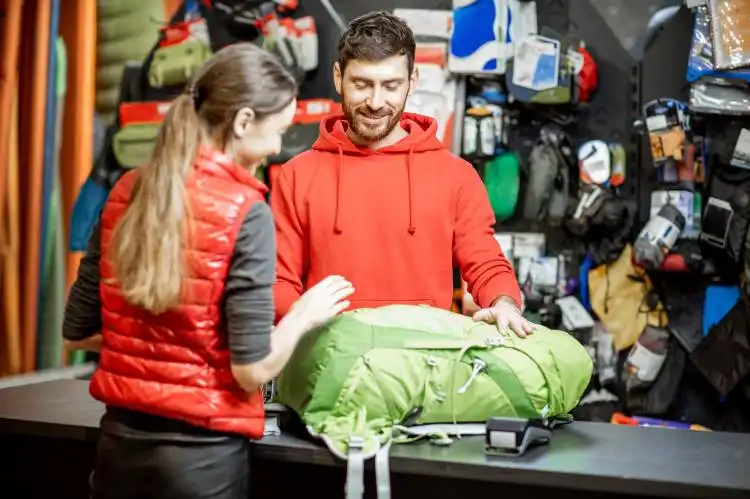Start a Fitness Apparel Business
Flexing Your Entrepreneurial Muscles with a Fitness Apparel Business
| Updated


FITNESS APPAREL BUSINESS
Dive into the wave of wellness with your very own fitness apparel business! This venture involves designing, manufacturing, and selling activewear tailored to the health-conscious and the athletically inclined. Who wouldn't want to profit while promoting healthy lifestyles? Just imagine, bringing style to sweats and glamour to gym gear - now that's a business model designed to flex your entrepreneurial muscles in the market!
Jump to Business Plan
RELATED BUSINESS IDEAS
Browse ALL Clothing & Fashion Trends Business Ideas
Discover Your Perfect Domain
Unlock the door to your online success with our hand-picked selection of premium domain names. Whether you're starting a new venture or rebranding an existing one, the right domain can set the tone for your digital presence. Browse through our curated list, each with its unique potential to enhance your brand's visibility and credibility.
FITNESS APPAREL MINI BUSINESS PLAN
This a quick reality check to help you identify the strengths and weaknesses of your business concept before you dive in.
Fitness Apparel Business Quick Facts
Expected Percent Margin:
- Gross Margin: 45-55%
- Net Profit Margin: 10-12%
Earnings Expectations:
- Daily Earnings: $125 - $400
- Weekly Earnings: $875 - $2,800
- Monthly Earnings: $3,750 - $12,000
- Annual Earnings: $45,000 - $144,000
Actions to Hit Those Numbers:
Product creation and sourcing:
- Initial Investment: Around $50,000 for sourcing and manufacturing high quality fitness apparel.
- Supplier Network: Establish connections with 2-4 reliable manufacturers offering quality materials.
Marketing and Customer Acquisition:
- Online Presence: Create an appealing website with features like online shopping, sizing guides, and customer reviews.
- Social Media: Regularly post exciting content to platforms frequently used by target audience.
- Influencer Partnerships: Collaborate with fitness influencers to broaden reach and credibility.
Sales and Customer Experience:
- Customer Service: Implement top notch customer service which includes easy exchange & return policies.
- Promotions: Run regular promotions & discounts on slower selling or seasonal items to keep inventory moving.
Cost Control:
- Logistics: Arrange a cost-effective shipping and handling process.
- Overhead costs: Maintain minimal employee strength and work towards automation for cost reduction.
Business Operations:
- New designs: Regularly introduce new designs to encourage repeat customers.
- Inventory Management: Use technology for inventory management to minimize overstock and avoid running out of popular items.
Remember, these figures are based on averages & may not directly apply to your unique situation. When planning, customize these based on your location, demographics, competition, and other market factors.
NOT WHAT YOU HAD IN MIND? Here are more ideas



Browse ALL Clothing & Fashion Trends Business Ideas
Grab Your Business Website Name
Before you get caught up in the whirlwind of setting up your business, invest in a domain name. It's a small but significant step that lays the foundation for your brand and makes it easier for customers to find and trust you. Just like you wouldn't build a house without securing the land first, don't build a business without securing your domain name.
"Why? Can't that wait?" Here's why it shouldn't
Step 1: Determine if the Business is Right for You
Breakdown of Startup Expenses
Before starting a fitness apparel business, it is important to understand the costs associated with getting the business up and running. This includes costs such as registering the business with the state, obtaining any necessary licenses, purchasing inventory, and creating a website. Additionally, you will need to factor in the cost of any equipment you may need, such as computers, printers, and other office supplies. It is also important to consider the cost of marketing and advertising your business, as well as any other fees associated with running the business.
Breakdown of Ongoing Expenses
Once the business is up and running, there are ongoing expenses that need to be taken into consideration. These include costs such as rent, utilities, payroll, and taxes. Additionally, you will need to factor in the cost of maintaining inventory, as well as any other costs associated with running the business. It is also important to consider the cost of marketing and advertising your business, as well as any other fees associated with running the business.
Examples of Ways to Make Money
There are a variety of ways to make money with a fitness apparel business. One way is to sell products directly to customers. This can be done through a website, a brick-and-mortar store, or through a combination of both. Additionally, you can make money by partnering with other businesses, such as gyms and fitness centers, to sell your products. You can also make money by offering custom apparel, such as personalized t-shirts and hats. Finally, you can make money by offering promotional items, such as water bottles and gym bags.
Step 2: Name the Business
When it comes to naming a business, it is important to make sure the name is memorable, easy to pronounce, and relevant to the business. It should also be unique and not already taken by another business. It is also important to consider the domain name, as it should match the business name. Additionally, consider the potential for a logo and how the name will look in print.
When brainstorming potential names, consider the target audience and the mission of the business. It is also important to consider the potential for expansion, as the business may grow in the future. Additionally, consider the potential for a tagline or slogan that can be used to further promote the business.
Once a list of potential names has been created, it is important to research the names to make sure they are not already taken by another business. Additionally, research the domain name to make sure it is available. Once the name has been chosen, it is important to register the business name with the local government.
Finally, it is important to trademark the business name to protect it from being used by another business. This will also help to protect the brand and ensure that the business is the only one using the name.
Step 3: Develop a Business Plan
Creating a business plan is an important step in starting a fitness apparel business. A business plan outlines the goals of the business and how they will be achieved. It should include a description of the business, the products or services offered, the target market, the competitive landscape, the marketing strategy, and the financial projections. It should also include a description of the management team, the operational plan, and the legal structure of the business. Additionally, the business plan should include a detailed budget and a timeline for launching the business.
Benefits of a Business Plan
Having a business plan is essential for any business, especially a fitness apparel business. It provides a roadmap for the business and serves as a reference for decision-making. A business plan also helps to secure funding from investors and lenders. It can be used to attract potential partners and employees, as well as to build credibility with customers and suppliers. Additionally, a business plan can help to identify potential risks and opportunities, and to develop strategies to address them.
Resources for Developing a Business Plan
There are a variety of resources available to help entrepreneurs develop a business plan. Many business schools and universities offer courses on business planning. Additionally, there are a number of online resources, such as the Small Business Administration, that provide templates and guides for creating a business plan. There are also a number of software programs available that can help entrepreneurs create a professional business plan. Finally, there are a number of consultants and advisors who specialize in helping entrepreneurs develop business plans.
Step 4: Obtain Licenses and Permits
Before starting a fitness apparel business, it is important to understand the types of licenses and permits that may be required. Depending on the type of business, the location, and the products being sold, the types of licenses and permits may vary. For example, if the business is selling apparel in a physical store, a business license, sales tax permit, and health permit may be required. Additionally, if the business is selling apparel online, a business license, sales tax permit, and a permit to do business in the state may be required.
Where to Obtain Licenses and Permits
Once the types of licenses and permits needed are identified, the next step is to obtain them. Depending on the state, licenses and permits may be obtained through the state government, local government, or both. Additionally, some states may require the business to obtain a federal license or permit. It is important to research the requirements for the state and local government to ensure the business is compliant.
Cost of Licenses and Permits
The cost of licenses and permits will vary depending on the type of business, the location, and the products being sold. Generally, the cost of licenses and permits will range from a few hundred dollars to a few thousand dollars. Additionally, some states may require the business to pay an annual fee to maintain the license or permit.
Timeframe for Obtaining Licenses and Permits
The timeframe for obtaining licenses and permits will vary depending on the state and local government. Generally, it can take anywhere from a few days to a few weeks to obtain the necessary licenses and permits. Additionally, some states may require the business to wait for approval before the license or permit is issued. Therefore, it is important to plan ahead and allow enough time to obtain the necessary licenses and permits.
Step 5: Find a Location
When choosing a location for a fitness apparel business, there are several factors to consider. First, the location should be accessible to customers. If the business is online, the location should be in a place with reliable internet access. If the business is a physical store, the location should be in a place with high foot traffic. Additionally, the location should be in a place with a large population of potential customers. It should also be in a place with low overhead costs, such as rent and utilities.
Options for a Physical Store
For a physical store, there are several options to consider. One option is to rent a space in a shopping mall or strip mall. This option is ideal for businesses that want to be in a high-traffic area. Another option is to rent a space in a commercial building. This option is ideal for businesses that want to be in a more private setting. Additionally, businesses can also rent a space in a warehouse or industrial building. This option is ideal for businesses that want to be in a more cost-effective setting.
Options for an Online Store
For an online store, there are several options to consider. One option is to use an e-commerce platform, such as Shopify or BigCommerce. This option is ideal for businesses that want to have a professional-looking website. Another option is to use a website builder, such as Wix or Squarespace. This option is ideal for businesses that want to have a more customized website. Additionally, businesses can also use a content management system, such as WordPress or Drupal. This option is ideal for businesses that want to have a more complex website.
Step 6: Set Up Finances
Setting Up a Business Bank Account
Before starting a fitness apparel business, it is important to set up a business bank account. This will help keep personal and business finances separate, which is important for tax and legal purposes. Additionally, it will make it easier to track expenses and income. When setting up a business bank account, it is important to research different banks to find the best rates and fees.
Obtaining Credit
Obtaining credit is an important part of setting up a business. Credit can be used to purchase equipment, inventory, and other necessary items. It is important to research different lenders to find the best rates and terms. Additionally, it is important to understand the different types of credit available, such as lines of credit, credit cards, and loans. It is also important to understand the credit requirements and how to build credit.
Step 7: Market the Business
Once the business is up and running, it is important to get the word out about the business. There are many ways to market a fitness apparel business. Examples include:
- Social media marketing: Creating social media accounts and utilizing them to post information about the business, such as new products, discounts, and special offers.
- Advertising: Placing advertisements in local newspapers, magazines, and online.
- Networking: Joining local business groups and attending networking events to meet potential customers and build relationships.
- Promotional materials: Creating flyers, brochures, and other promotional materials to distribute to potential customers.
- Email campaigns: Sending out emails to potential customers to inform them about the business and its products.
Tips for Successful Marketing
Successful marketing is key to the success of any business. Here are a few tips to help ensure successful marketing of a fitness apparel business:
- Have a clear message: It is important to have a clear message about the business and what it offers.
- Focus on the target audience: It is important to focus on the target audience when marketing the business.
- Utilize multiple channels: Utilizing multiple channels, such as social media, advertising, and email campaigns, can help reach a larger audience.
- Track results: It is important to track the results of marketing efforts to determine what is working and what is not.
- Monitor the competition: It is important to monitor the competition to ensure that the business is staying ahead of the competition.
Step 8: Hire Employees
When it comes to hiring employees, it is important to find the right people who will be a good fit for the business. Start by creating a job description that outlines the qualifications and duties of the position. This will help to ensure that the right people are hired. Additionally, it is important to conduct background checks and interviews to ensure that the right people are hired. It is also important to consider the cost of hiring employees, including wages, benefits, and other expenses.
Benefits of Hiring Employees
Hiring employees can be beneficial to a business in many ways. Employees can help to reduce the workload of the business owner, allowing them to focus on other aspects of the business. Additionally, employees can bring fresh ideas and perspectives to the business. They can also help to increase productivity and efficiency. Finally, having employees can help to create a positive work environment and provide customer service.
Step 9: Monitor the Business
Monitoring the business is an important step to ensure that the business is running smoothly and efficiently. It is important to track the progress of the business, including sales, customer feedback, and expenses. Additionally, it is important to track the progress of marketing campaigns and other initiatives.
Analyzing Data
Analyzing data is an important part of monitoring the business. This includes tracking sales, customer feedback, and expenses. It is also important to track the progress of marketing campaigns and other initiatives. Additionally, it is important to look at trends in the industry to see what is working and what is not. This can help to inform future decisions and strategies.
Making Adjustments
Once the data has been analyzed, it is important to make adjustments to the business as needed. This could include making changes to the marketing strategy, pricing, or product offerings. Additionally, it is important to adjust the business model as needed to ensure that it is meeting the needs of customers and staying competitive in the market.
Keeping Up With Trends
It is also important to keep up with trends in the industry. This includes staying up to date on new products, services, and technologies. Additionally, it is important to stay informed about changes in customer preferences and the competitive landscape. This can help to inform future decisions and strategies.
EXPLORE MORE CATEGORIES
Browse ALL Business Idea Categories
TAKE THE NEXT STEPS










